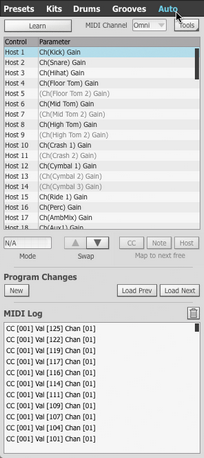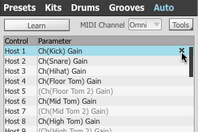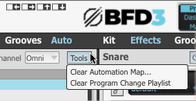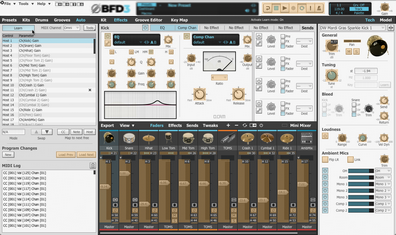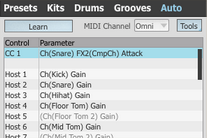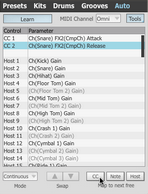The Automation panel allows you to view, create and modify MIDI and host automation assignments to BFD3 parameters.
It also provides access to the Program Change Playlist - see the next section for details of this function.
The Automation panel is not visible at the same time as BFD3's Browser - to make it visible, click the Auto button above the Browser.
|
To exit the Automation panel, click the Auto button again to hide it or click any other Browser tab button to display it instead. MIDI automation and host automation MIDI and host automation both have their own advantages and disadvantages: Hardware MIDI controllers tend to be cheap and widely available while host automation controllers can tend to be less plentiful and more expensive. Despite this, it is usually possible to simply draw automation data in terms of lines and curves directly in your host instead of using hardware to create this data. It is also usually possible to draw MIDI CC automation in a similar way. Please check your host's documentation for more details on its support for MIDI CCs and host automation. Host automation tends to offer greater resolution (although this varies wildly depending on your particular DAW's implementation) while MIDI CCs are limited to 7-bit resolution (128 steps), which can lead to smoother automation. In the case of MIDI, BFD3 is capable of using both MIDI continuous controllers (CCs) and MIDI notes. The latter are particularly useful for automating button-type controls.
Automation panel layout MIDI channel Automation Map assignments can be created on any MIDI channel. By default, BFD3 responds in Omni mode - in other words, on any MIDI channel. This can be changed to a specific channel from 1-16 using the MIDI Channel drop-down menu. Automation assignments can exist on a separate MIDI channel to that used for the Key Map - its MIDI channel setting is entirely distinct. Setting a different MIDI channel to that used for the Key Map is useful when using significant numbers of MIDI note mappings. |
The current MIDI Channel setting applies to all current automation assignments, regardless of the MIDI channel used when it was created.
Learn button
Activate this button to enter Learn mode, used for the process of mapping BFD3 parameters to automation control sources. See the guide below for details of how to use this button.
Map to next free
These 3 buttons are also used in the mapping process - see the guide below for details.
Mapped parameters list
|
This list displays current automation mappings as well as program changes for the program change playlist. Program changes are always displayed underneath automation mappings. The Program Change playlist is discussed in the next section. Each mapped Parameter is shown to the right of the Control source to which it is assigned. Delete mapping When the cursor is hovered above a mapping in the list, a Delete mapping button ('X') is shown at the right. Click the button to delete the mapping. |
Swap
These buttons swap the assignments of adjacent MIDI CCs/host automation parameters.
Mode
This setting is used to adjust the behaviour of the selected mapping in the Mapped paramater list. See below for a guide to using this setting.
Program Changes
This part of the panel is discussed in the next section.
MIDI Log
The MIDI Log provides an overview of incoming MIDI messages, useful for troubleshooting mapping operations.
Tools menu
|
Clear Automation Map This function clears all current automation assignments of all types. You are prompted for confirmation before this function is applied. Clear Program Change Playlist This function clears the Program Change Playlist, discussed in the next section. |
Creating an automation assignment
|
1. First, display the Automation panel if it is not currently visible, using the Auto button above the Browser.
2. Then click the Learn button in the Automation Panel. The BFD3 interface changes to highlight any controls that can be automated. Any existing automation mappings are labelled on the control. In this state, you can use the interface to display the desired control if it is not currently visible. |
3. The assignment is then created in any of the following ways:
Learn an incoming message
|
•Click the parameter within the BFD3 interface you wish to assign to an automation control source.
•Move/adjust the hardware knob/fader/key to which you wish to map the BFD3 parameter. •Alternatively, suitable data can be drawn/painted within a track in your host/DAW and played into the BFD3 plugin. Usually, values are sent as they are drawn - please consult your host's documentation for details on sending values for MIDI CCs, host automation parameters and MIDI notes.
•The BFD3 parameter is now labelled with the learned automation source to confirm that it is now mapped. |
The mapping is also shown in the Mapped parameters list in the Automation panel. MIDI assignments are shown above host automation assignments. |
Use the Map to next free function
|
•Click the parameter within the BFD3 interface you wish to assign to an automation control source. |
|
•Click one of the Map to next free buttons in the Automation panel to map the BFD3 parameter to the next unmapped CC, Note or Host automation source.
The mapping is now shown on the BFD3 parameter and in the Mapped parameters list in the Automation panel.
|
Adjusting automation behaviour for a mapping
The Mode setting changes the behaviour of the selected mapping in the Mapped paramater list. Click the button to display a drop-down menu of the 3 following settings:
|
Continuous (default for MIDI CCs) This is the default mode and the most typically useful way to control a fader or knob – the fader or knob's value follows the MIDI CC values continuously. Switch This mode is intended to be used when controlling button parameters with MIDI CCs. The MIDI CC range is divided in two, with values of 0-64 triggering an 'Off' state and values of 65-127 triggering an 'On' state. This mode can also be used with MIDI notes - notes with a velocity between 0-64 switch the BFD3 parameter to an 'Off' state, while notes with a velocity between 65-127 switch the BFD3 parameter to an 'On' state. Toggle This mode is available for MIDI note assignments and sets the assignment to 'latching'-style behaviour – play the note once and release it to trigger an 'On' state, and play/release the note again to return it to its 'Off' state. This mode is recommended when assigning the Record/Loop transport buttons to MIDI notes. |
Momentary
This mode is available only for MIDI note assignments - the assigned BFD3 parameter is set to an 'On' state while the MIDI note is held down (when it sends a MIDI note on message).
Upon release of the MIDI note (when a MIDI note off message is received) the control returns to its 'Off' state.
This mode is recommended when assigning the Play/Stop/Return to Start transport controls.
Saving the Automation Map
All the following functions can be found in BFD3's File menu.
Save Automation Map
This function opens a system file save dialog prompting for a location and filename to save the current Automation Map.
It is recommended to save the Automation Map to the default location - <user location>/Maps - so that it is accessible from the Load Automation Map panel without further adding and scanning of data locations.
Save Key + Automation maps
Save MIDI Event Log
See the MIDI Key Maps section for details on these functions.
